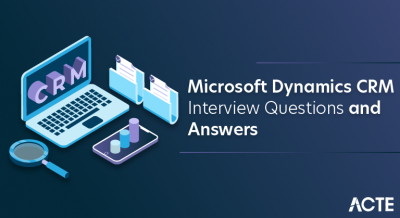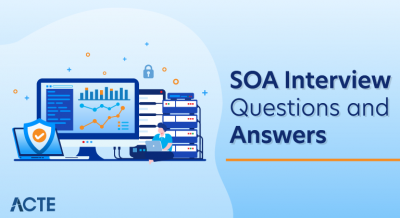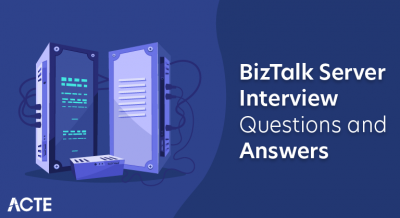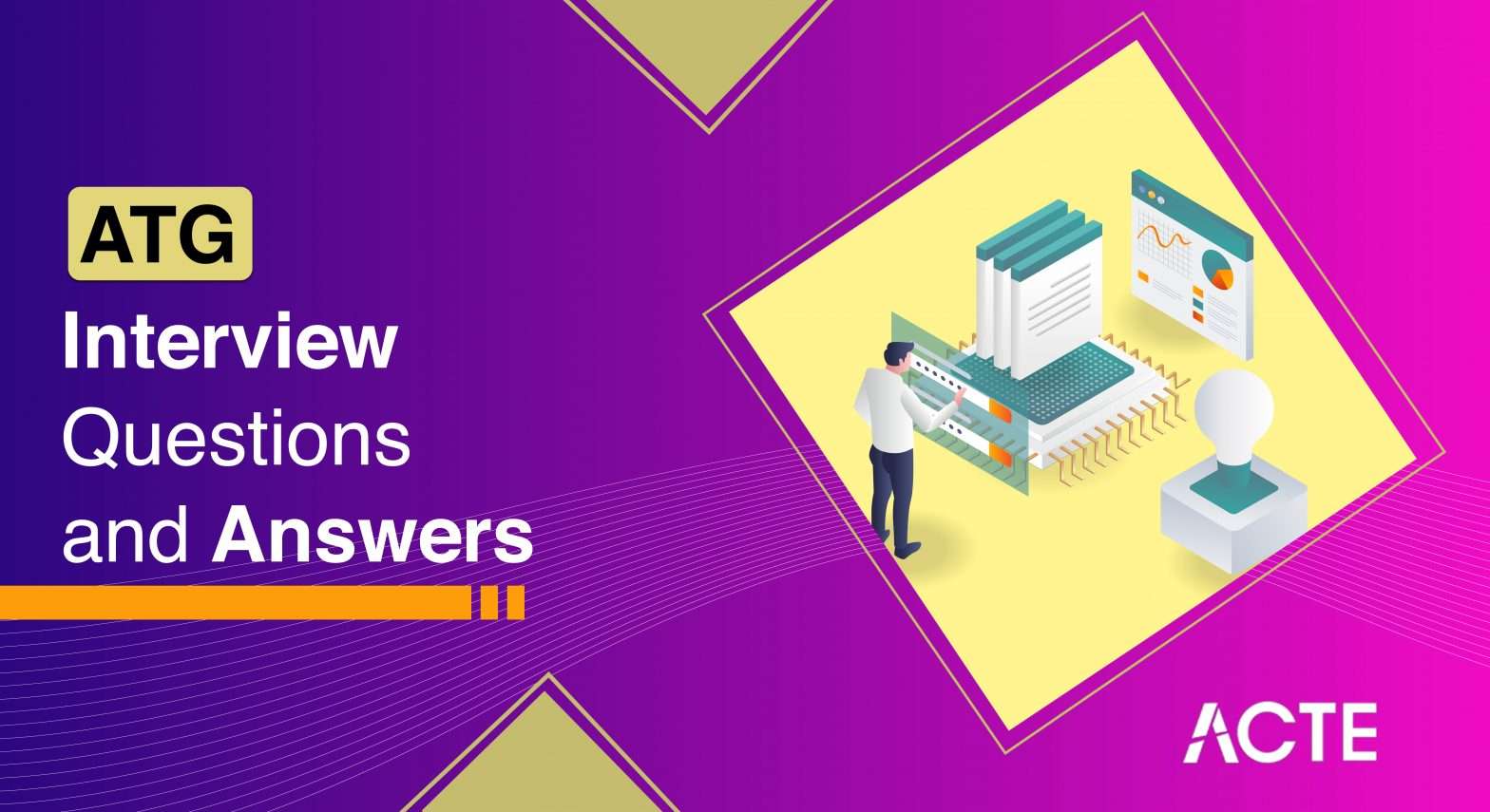
Oracle ATG (Art Technology Group) Web Commerce is a comprehensive and robust e-commerce platform designed to create and manage dynamic, personalized, and scalable online shopping experiences. Leveraging Java-based technology, ATG offers a suite of modular components and tools that empower businesses to build and customize their digital storefronts, manage product catalogs, streamline checkout processes, and optimize marketing campaigns.
1. What is an ATG storehouse?
Ans:
A repository is a data access layer that provides a general representation of a data store. It makes it easier to store and retrieve data. Data manipulation is done using the Repository API. Application developers can only access data through interfaces like Repository and RepositoryItem. This abstraction promotes consistency and simplifies interactions with the underlying data sources.
2. What is an item descriptor?
Ans:
- Let’s keep things simple with the help of a SQL Repository.
- For example, each database table has its repository item description.
- Sometimes, a JOIN of many tables results in a single item descriptor.
- ATG repositories enable Java collections, including Lists, Maps, and Arrays.
- They also support one-to-one, one-to-many, and many-to-many connections.
3. How to set up a repository?
Ans:
A database table (e.g., tb_tango) requires a property file that includes the XML file, class file, data source, repository mapping, and so on. This file can be named “sampleFile.properties.” The mapping XML file (repositoryMapping.xml) defines the repository item descriptors. The final step involves registering the repository with Dynamo. Proper configuration of these components is essential for seamless integration and functionality within the system.
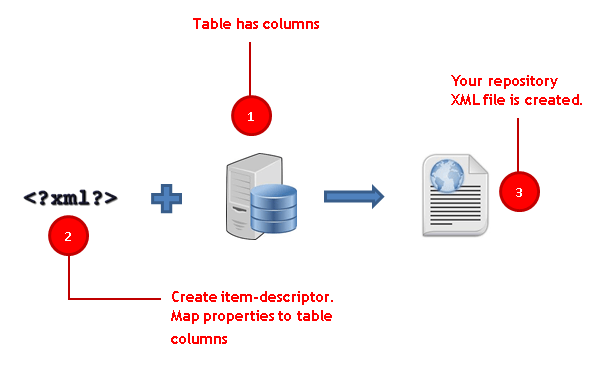
4. What is the definition of ATG Dynamo? What is the ATG Framework?
Ans:
ATG Dynamo, sometimes known as Dynamo Application Server (DAS), is a J2EE application server by Art Technology Group. The Atg framework is a Web Application framework for developing web apps. ATG Dynamo is responsible for implementing the ATG framework. The application framework is compatible with all significant J2EE application servers, including JBoss, WebLogic, and WebSphere.
5. What is the Nucleus?
Ans:
The ATG 7 Web apps are simply a collection of separate JavaBean components specified and linked together via properties files in the Nucleus. Each service in the Nucleus is represented as a JavaBean or a collection of JavaBeans. These JavaBeans are set up individually and then mounted in a namespace. The beans then interact with the beans that represent other services. The Nucleus interprets component configurations and manages the component namespace.
6. What is the concept of DevOps, and what are its benefits?
Ans:
- The DevOps set of practices combines software development (Dev) and IT operations (Ops) to improve collaboration and productivity. It emphasizes automation, Continuous Integration, continuous delivery, and monitoring throughout the software lifecycle.
- Benefits include faster time to market, improved deployment frequency, and more stable operating environments. Tools like Jenkins, Docker, and Kubernetes facilitate these practices, enhancing efficiency and quality.
7. What is the ATG Tag Library?
Ans:
- Collection of Custom Tags: A grouping of specialized JSP tags that support web application development by offering reusable components for frequently performed tasks.
- Seamless Integration with ATG Framework: Built to function smoothly with the ATG platform, enabling developers to utilize features like personalization, content management, and dynamic routing.
- Streamlines JSP Development: Simplifies the handling of complex operations in JSP pages, minimizing the need for extensive Java code and improving maintainability.
8. What is the difference between DSP: include and jsp: include?
Ans:
| Feature | <dsp:include> | <jsp:include> |
|---|---|---|
| Context | Oracle ATG Dynamo Servlet Pages (DSP) | Standard JavaServer Pages (JSP) |
| Usage | Used within Oracle ATG Web Commerce | Used in any Java EE compliant web app |
| Inclusion Type | Dynamic inclusion at runtime | Static (<%@ include %>) or dynamic (<jsp:include>) |
| Framework Dependency | Proprietary to Oracle ATG framework | Part of the standard Java EE platform |
9. What is the class hierarchy for ATG FormHandlers, and how can a FormHandler be created?
Ans:
- At the top of the ATG form handler class hierarchy, there is The DropletFormHandler interface. Dynamo provides three alternative classes that extend this interface. They’re as follows:
- At. Droplet.EmptyFormHandler: tag. Droplet.Generic Form Handler: tag. Droplet.TransactionalFormHandler
- The EmptyFormHandler is the easiest to implement. It implements the DropletFormHandler interface and provides blank body implementations of its functions.
10. What is the ATG DPS? What are its constituent elements?
Ans:
ATG DPS stands for the ATG Dynamo personalization system. User profiles and businesses fuel it. Rules ensure that the appropriate content is delivered to the correct user. The ATG DPS Personalization System consists of three major components. Manage user profiles, target content, and send targeted emails. User Profile Management. When a person visits a website powered by ATG Dynamo Personalization Server (ATG DPS) for the first time, they are prompted to create their own User Profile.
11. Explain the ATG performance concerns.
Ans:
Performance difficulties come in a variety of shapes and sizes, but they all indicate that some work needs to be processed at the expected and previously observed speed. Performance difficulties include CPU utilization problems and poor responsiveness. Times, high levels of database activity, long-running SQL queries, and slow CA deployments, to mention a few.
12. What’s the difference between Item Cache and Query Cache?
Ans:
- The Item Cache stores individual items retrieved from the repository to enable faster access to frequently used data, while the Query Cache keeps the results of specific queries for quicker retrieval of data sets that meet certain criteria.
- The Item Cache emphasizes caching specific items that can be accessed directly through their unique identifiers, whereas the Query Cache focuses on caching the entire result set of a query, which can include multiple items.
- Items in the Item Cache may expire based on individual attributes or access patterns, while entries in the Query Cache typically adhere to a shared expiration policy determined by the query criteria.
13. What are the different types of caching?
Ans:
Caching modes are configured at the item descriptor level using the tag’s cache-mode attribute. The default caching mode is basic caching. To change the caching mode for an item descriptor, set the cache mode to one of the following values:
- \tSimple
- \tLocked
- \tDistributed (TCP and JMS caching)
- \tDistributedHybrid (Hybrid caching)
14. What use does the ATT merchandising server or BCC serve?
Ans:
- ATG supplies the ATT merchandising server, or BCC, which serves as a business control center.
- BCC supports marketers with the management of catalogs, products, and materials like PDFs and photos.
- Additionally, BCC enables real-time analytics and reporting, allowing marketers to track performance metrics and make informed decisions.
- It also facilitates seamless integration with other systems, enhancing overall operational efficiency and streamlining workflows across different marketing functions.
15. What use does the versioned database serve within ATG?
Ans:
A basic schema for documenting user information, prices, audits, and assets. Management is the versioned database. Changes to the publishing schema are made at the first point of contact for merchandisers, which is the publishing schema. It acts as the foundation for all changes to the website. This schema ensures consistency and accuracy in the data management process, allowing for efficient updates and modifications. Moreover, it supports the scalability of the system, enabling the addition of new features and functionalities as business needs evolve.
16. What purpose does architecture serve?
Ans:
- The architecture is a mechanism that ensures the website follows the correct schema and checks the database for changes.
- It allows modifications to be made without the requirement for server restarts or deployment procedures.
- It also ensures scalability by efficiently handling multiple requests and maintaining session integrity. Moreover, the architecture supports automated updates and version control to minimize downtime and streamline maintenance processes.
17. What role does the State server play within the architecture?
Ans:
- The State server, a discretionary component of the design, allows merchandisers to assess changes before committing them to the catalog.
- This practice helps to verify the accuracy of modifications before deploying them on the production server.
- It provides a safe environment for testing the impact of pricing, inventory, or product description changes without affecting live data.
- Merchandisers can collaborate on proposed updates, reviewing and adjusting them to ensure alignment with marketing strategies and customer expectations before final implementation.
18. What kind of databases does the architecture support?
Ans:
The architecture is made up of four database categories: publishing, cataloging, state, and course. When it comes to website changes, the publishing and cataloging databases are consulted, while the state database is used to review changes before they are implemented. The course database is not a versioned repository, and the merchandise does not track changes.
19. What role does the course schema play within the architecture?
Ans:
The course schema functions as an asset management database that is not versioned. This feature allows for adjustments to be made without affecting the version history, simplifying asset management and eliminating the need for server restarts and deployment procedures. Changes can be implemented rapidly, streamlining the workflow for administrators and content managers. It reduces operational overhead by enabling real-time updates to the database without interrupting ongoing processes or requiring downtime.
20. What purpose does the text’s core structure serve?
Ans:
The core schema includes tables for order, profile, and price. Its goal is to store data that does not require regular updates, such as user profiles and order information. The schema’s key aims are to ensure efficient operations and data integrity. By minimizing frequent changes, it helps optimize database performance and reduce the load on the system. This stable structure also supports reliable reporting and analytics by maintaining consistent, up-to-date records.
21. What distinguishes B2C e-commerce sites from B2B ones?
Ans:
- B2C e-commerce websites allow people to buy products and services directly from the site, whereas B2B e-commerce sites facilitate transactions between organizations.
- B2C models, like those used by Amazon and Flipkart, allow anybody to register and place an order, but b2b models often require registration and a written contract.
22. What is the literary definition of a nucleus?
Ans:
In literary terms, the “nucleus” refers to the central, most essential element of a narrative or a literary work, around which the plot, characters, and themes are developed and organized. It is the core idea or the pivotal event that drives the story forward, serving as the focal point that gives the work its cohesion and purpose. The nucleus can be a defining moment, a key conflict, or a fundamental theme that resonates throughout the text, influencing the actions and motivations of the characters, as well as the overall direction of the plot.
23. What is the way in which ATG aids in managing product catalogs?
Ans:
- Rewrite the text using the same language and with the same word count.
- ATG aids in managing product catalogs by using a solid repository system to store and categorize product information.
- It offers resources for making, modifying, and organising items, enabling companies to manage product characteristics, details, pictures, and stock data effectively.
- Rephrase this text while maintaining the same language as the original and using an equal number of words.
24. What is the purpose of form handlers?
Ans:
Form handlers are used in web applications to manage and process user input collected through HTML forms. Their primary purpose is to handle the data submitted by the user, validate the input for correctness and security, and then perform necessary actions such as storing the data in a database, updating records, or triggering business logic. Form handlers can also provide feedback to the user, such as error messages for invalid input or confirmation messages upon successful submission.
25. Which scope is best for a text droplet and a form handler?
Ans:
For a text droplet and a form handler, the most appropriate scope is typically the request scope. This scope is best suited because it ensures that the data processed by the droplet and form handler is specific to a single HTTP request, preventing data from being inadvertently shared across multiple requests or users. Using request scope helps maintain data integrity and user session privacy by isolating each user’s interaction with the application.
26. What are the capabilities of Dynamo Components?
Ans:
- HTTP request handling (Servlet Beans).
- Dynamic content rendering (Droplets).
- Web form processing (Form Handlers).
- Request/response pipelines.
- Dependency management (Nucleus).
27. What is the purpose of an Item Descriptor?
Ans:
In the context of ATG Commerce, an item descriptor defines the structure and properties of items stored in the ATG Repository. It provides a guide for setting up the repository’s data management and organization, defining the characteristics, data types, and links between them, as well as indexing data for various things, such as goods or categories.
28. Which class should be extended while constructing ATG Droplets?
Ans:
- When constructing ATG Droplets, it is typical to extend the ‘DropletFormHandler’ class.
- The ‘DropletFormHandler’ is a base class provided by the ATG framework for creating droplets.
- Custom logic may be added to handle form submissions, run business logic, and produce HTML or other content to be displayed in response to user interactions on web pages by extending this class.
29. Describe ATG Dynamo.
Ans:
ATG Dynamo is an e-commerce application framework developed by ATG, now part of Oracle. It provides the runtime environment for building web applications, featuring components like Servlet Beans and Droplets for request processing and rendering dynamic content. It supports personalization and targeting capabilities, allowing businesses to deliver tailored experiences to users based on their behavior and preferences.
30. What does the ATG Pipeline serve?
Ans:
- Request Handling: Manages HTTP request processing.
- Modularity: Supports easy processor management.
- Performance: Enables parallel execution.
- Customization: Tailors functionality to specific needs.
- Error Handling: Manages exceptions gracefully
31. What is DAF in ATG?
Ans:
DAF, or the Dynamic Application Framework, is a fundamental element of ATG that facilitates the development of e-commerce applications. It offers a collection of reusable components and services aimed at simplifying common tasks like data access, user authentication, and session management. By utilizing DAF, developers can create dynamic and scalable applications that capitalize on its inherent features for managing data persistence and business logic.
32. Explain how ATG is integrated with search engines for searching products.
Ans:
- Rewrite the text using the same language and number of words.
- Combining ATG with search engines to improve product search functionality:
- ATG establishes a connection with external search engines.
- Information about the product is organized and stored in an index.
- Requests are dispatched in order to achieve quicker and more precise outcomes.
33. What is the role of ATG in assisting with order processing and fulfillment?
Ans:
Rewrite the text below using the same language and the same number of words: Please rewrite the text below using the same language while keeping the word count constant. ATG makes order management and fulfillment easier by consolidating order information, managing inventory, and allowing for order tracking. It establishes a unified method for handling orders, ensuring stock availability, and executing efficient order fulfillment procedures, ultimately enhancing the customer experience.
34. How can a custom droplet be created in ATG?
Ans:
- Create Java Class: Extend ‘DynamoServlet’ and override the ‘service()’ method for request processing.
- Define Parameters: Use ‘DynamoHttpServletRequest’ to get inputs and ‘DynamoHttpServletResponse’ to output data.
- Configure in Nucleus: Create a ‘.properties’ file to register the droplet and set parameters.
- Use in JSP: Reference the droplet in JSP with ” tags for input/output.
35.What is the ATG nucleus?
Ans:
The system that provides such parts with a home and a means of existence is called the nucleus. To find each other. It organizes application components into a hierarchy and assigns a name to each element based on its position in the hierarchy. Nucleus allows components to easily interact and reference each other by their hierarchical names. It also handles component lifecycle management, such as instantiation and configuration, ensuring smooth application execution.
36. What is a pipeline in ATG?
Ans:
An answer that permits the execution of code in modules is a pipeline. Oracle ATG Web Commerce uses pipelines to carry out operations like loading, storing, and checking out orders. The pipeline execution mechanism is put into practice by the Pipeline Manager. Pipelines consist of a sequence of pipeline processors, each responsible for a specific task in the operation. This modular approach enhances flexibility, allowing different processors to be easily modified or replaced without affecting the entire system.
37. What is ATG DPS, and what components make it up?
Ans:
- The ATG Dynamo personalization system is referred to as ATG DPS. Its power comes from business rules created to provide the appropriate content to the appropriate user, along with user profile data.
- The ATG DPS Personalization System consists of three essential components.
- Targeted email Q10; content targeting; user profile management. ATG Form Handlers:
- The class that sits in between a JSP form value and its bean class is called the ATG form handle.
38. How is code scalability ensured?
Ans:
- Scalability starts with designing modular and decoupled code, allowing individual components to scale independently.
- Using efficient algorithms and data structures improves performance.
- Caching mechanisms are leveraged to reduce the load on databases and optimize response times.
- Implementing load balancing distributes traffic evenly across servers.
- Monitoring and profiling the application help identify bottlenecks.
39. What benefit does Nucleus offer to ATG?
Ans:
It provides an easy method for writing new components. Applications can create instances of components in Nucleus without requiring code. Configuration files are used to create and manage it. Layers are created by arranging configuration files. Application developers can easily set the scope of their components with Nucleus because it offers a multitude of pre-built, generalized service components and An easy method to extend and change the attributes of elements.
40. Explain the distinctions between DSPs. What functionalities do Dynamo Components have?
Ans:
- Managing HTTP requests with Servlet Beans.
- Displaying content dynamically (Droplets).
- Processing of web forms (Form Handlers).
- Series of requests and corresponding responses.
- Management of dependencies within the Nucleus.
41. Why is an Item Descriptor necessary?
Ans:
Rephrase the text using the same language and maintaining the word count: Rewrite the text using the same language and word count: In ATG Commerce, an Item Descriptor is used to specify the format and characteristics of items kept in the ATG Repository. It offers guidance on establishing the data management and organization of the repository, specifying attributes, data types, and relationships while also indexing data for items or groups.
42. When creating ATG Droplets, is it recommended to expand the ‘DropletFormHandler’ class usually?
Ans:
- The ATG framework offers the ‘DropletFormHandler’ as a foundational class for developing droplets.
- By extending this class, unique logic can be incorporated for managing form submissions, executing business functions, and generating content like HTML to be shown in response to user interactions on web pages.
- Rewrite the following text while maintaining the same input language and word count.
43. What is ATG Dynamo?
Ans:
ATG Dynamo is an e-commerce application framework that was initially developed by ATG and is now a part of Oracle. It provides a powerful runtime environment for developing web applications specifically designed for online commerce. Among its essential components are Servlet Beans and Droplets, which assist in processing requests and generating dynamic content. The framework also offers advanced capabilities like personalization, allowing businesses to create tailored experiences based on user interactions.
44. What is the purpose of the ATG Pipeline?
Ans:
- Rewrite the text using the exact words and language.
- Request Handling handles the management of HTTP request processing.
- Modularity makes processor management simple.
- Performance: Allows for simultaneous execution.
- Customization involves adapting functionality to suit particular requirements.
- Error Handling: Handles exceptions gracefully.
45. Which form handler is primarily used for the shopping cart?
Ans:
Rephrase the following text using the same input language and maintain the exact word count: Revise the subsequent text using the identical input language and preserve the same number of words: The main form handler in Oracle ATG Commerce that is responsible for managing the shopping cart is commonly known as the “ShoppingCartFormHandler”. This form handler manages different tasks involving the shopping cart, like adding items, removing items, adjusting quantities, and starting the checkout process.
46. What is the reason for using Eclipse with ATG?
Ans:
Rephrase the above text utilizing the same source language while maintaining the word count: Rewrite the given statement using the same input language and word limit. Eclipse is utilized in conjunction with ATG for: IDE stands for Integrated Development Environment. ATG Tools provides personalized plugins and tools. Collaboration aids in promoting team effort.
47. What is the significance of the ATG development environment?
Ans:
- Integrated Toolset: Provides a comprehensive collection of tools, such as the ATG Business Control Center, for streamlined development and deployment.
- Modular Architecture: Supports reusable components, accelerating development and enhancing code maintainability.
- Personalization Support: Enables customized user experiences based on customer behavior, boosting engagement and conversion rates.
- Effortless Integration: Allows for smooth integration with third-party systems, resulting in cohesive solutions that optimize operations.
48. What is the process to modify or enhance current ATG components?
Ans:
Rewrite the text using the same language and word count. To alter or enhance ATG components, a new component should be created based on the target component. Substitute specific functions or attributes, set up the personalized component in XML documents, and verify its functionality prior to deployment. Additionally, ensure that the new component adheres to the existing architecture and coding standards for consistency.
49. Why was the ATG Control Center created?
Ans:
Rewrite the text using the same language and word count. The ATG Control Center acts as the central hub for controlling and setting up an ATG application. Administrators can manage system configurations, user access, monitoring, content management, and customer and order handling through it. It simplifies administrative duties for e-commerce and website control.
50. Why is the ATG logging framework critical?
Ans:
The text should be rephrased using the same input language without changing the word count. The ATG logging framework plays a vital role in the following:
Identifying and debugging problems.
- Monitoring of systems in real-time.
- Records of actions taken to ensure conformity with regulations.
- Identifying and repairing problems, as well as upkeep.
51. How does ATG manage product suggestions and cross-selling?
Ans:
Rewrite the text using the same language and the exact word count. ATG employs a recommendation engine to examine customer data and offer immediate product recommendations according to customer behavior. This method boosts chances to upsell and promotes cross-selling by recommending related products to customers while they browse and shop on e-commerce platforms.
52. Describe how SKU inheritance works within ATG.
Ans:
Correct. Rephrasing the text while retaining the exact word count: In ATG, the inheritance of SKUs (Stock Keeping Units) enables businesses to handle related products effectively. Through the concept of SKU inheritance, a base SKU acts as a blueprint, sharing similar characteristics and pricing guidelines with related SKUs. Changes made to the main SKU are automatically applied to its offspring, making product management easier.
53. What is ATP’s role in assisting with SEO optimization for online shopping sites?
Ans:
- URLs that can be personalized to meet specific preferences.
- Managing metadata.
- Canonical URLs are the preferred URLs for a specific web page.
- Creation of a website map.
- Content that is both SEO-friendly and dynamically updated.
- Rephrase the text using the same input language and maintaining its original word count.
54. Explain ATG’s approach to managing user sessions in a clustered setting.
Ans:
Rewrite the text using the same input language while maintaining the exact word count. In a clustered setting, ATG handles user sessions by replicating sessions to maintain consistent data across nodes. Load balancing ensures that user requests are evenly spread across nodes to achieve the best performance. A failover mechanism ensures session continuity by redirecting sessions to working nodes when one fails. Sticky sessions are utilized to maintain a user on the identical node throughout the session.
55. What advantages does ATG’s REST Web Services framework offer for API development?
Ans:
- Rewrite the text using the same input language and maintaining the exact word count.
- Integration made more accessible: Simplifies integration with third-party systems.
- Scalability: Able to handle heavy amounts of traffic.
- Based on resources: follows REST guidelines.
- Flexibility means the ability to create custom APIs.
- Security: offers strong validation and permission confirmation.
56. What is the process of building personalized repositories and expanding the ATG repository framework?
Ans:
Building personalized repositories and expanding the ATG repository framework entails several important steps. First, you should define the repository structure in XML, detailing the layout and components for storing user-specific information. Next, incorporate customization features that utilize user preferences and behaviors to ensure the repository can meet individual requirements. Afterward, integrate the personalized repositories with existing ATG services to improve functionality and data access.
57. How does ATG manage user sessions and shopping cart information across devices?
Ans:
ATG handles user sessions and shopping cart data across devices using a comprehensive session management framework. It employs cookies and session identifiers to monitor users as they move through various pages, providing a smooth and uninterrupted experience. User session information is centralized in a repository, allowing retrieval from multiple devices without losing data. Furthermore, ATG offers persistent shopping carts that retain items even after users log out or change devices.
58. What are some typical security guidelines for creating ATG applications?
Ans:
- User Authentication: Utilize strong authentication methods, such as enforcing robust password policies and incorporating multi-factor authentication, to ensure that only permitted users can access the application.
- Data Encryption: Employ encryption protocols (e.g., SSL/TLS) for both data transmission and storage to safeguard sensitive user data and prevent unauthorized access.
- Input Validation: Ensure all user inputs are validated to mitigate injection attacks and other vulnerabilities. Properly sanitize and validate data before processing it.
59. How does ATG Commerce Suite improve customer experiences?
Ans:
ATG Commerce Suite enhances customer experiences through personalization and customization. It uses data analytics to understand user behavior and preferences, delivering tailored product recommendations. The suite also includes advanced search functionalities, helping customers find what they need quickly. Its dynamic content management allows businesses to update content in real time, ensuring relevance.
60. What are the critical components of the ATG Commerce Suite?
Ans:
The ATG Commerce Suite comprises several key components: Commerce Service Center, which provides tools for customer service representatives; Merchandising, which allows for effective product management and promotion; Personalization, offering tailored user experiences; Search and Navigation, enhancing product discoverability; Order Management, ensuring efficient processing and fulfillment; and Business Intelligence, delivering actionable insights through data analysis.
61. What role does ATG play in Oracle’s ecosystem?
Ans:
Within Oracle’s ecosystem, ATG plays a pivotal role in enhancing Oracle’s Customer Experience (CX) suite. It provides:
- Advanced eCommerce capabilities.
- Integrating with other Oracle products such as Oracle Marketing Cloud.
- Oracle Sales Cloud.
- Oracle Service Cloud.
62. How does ATG ensure scalability and performance?
Ans:
ATG ensures scalability and performance through its robust architecture and use of industry-standard technologies. It employs a modular, service-oriented architecture (SOA) that allows for flexible scaling of individual components. ATG leverages caching mechanisms to reduce server load and improve response times. Its distributed deployment capabilities enable load balancing across multiple servers. Additionally, ATG supports Integration with cloud services, offering on-demand scalability.
63. What industries benefit most from ATG’s solutions?
Ans:
ATG’s solutions are particularly beneficial for industries with significant eCommerce operations, such as retail, consumer goods, telecommunications, financial services, and travel and hospitality. In retail and consumer goods, ATG enhances online shopping experiences through personalized recommendations and efficient order management. Telecommunications companies use ATG to manage complex service offerings and customer interactions.
64. What are the security features of ATG’s platform?
Ans:
- ATG’s platform incorporates several security features to protect customer data and ensure safe transactions. It includes data encryption protocols for secure data transmission and storage.
- The platform supports compliance with industry standards like PCI-DSS for payment security.
- ATG also offers role-based access controls to limit data access to authorized personnel only.
- Additionally, it features fraud detection mechanisms and transaction monitoring to prevent fraudulent activities.
65. How does ATG integrate with other systems?
Ans:
ATG integrates with other systems through its flexible, standards-based architecture. It uses APIs and web services to facilitate seamless data exchange with third-party applications. ATG supports Integration with popular ERP, CRM, and marketing automation systems, enabling a unified view of customer data and business operations. This capability enhances overall efficiency by allowing businesses to synchronize processes and improve decision-making across platforms.
66. What advancements has ATG made in personalization technology?
Ans:
ATG has advanced personalization technology through sophisticated data analytics and machine learning algorithms. Its personalization engine analyses user behavior, preferences, and purchase history to deliver targeted content and product recommendations. ATG uses real-time data processing to adapt offers and content dynamically based on user interactions. It also integrates with social media platforms to leverage additional customer insights.
67. What support and services does Oracle offer for ATG users?
Ans:
- Oracle offers comprehensive support and services for ATG users, including technical support, consulting, and training.
- Technical support includes 24/7 assistance, regular updates, and patches to ensure system reliability and security.
- Oracle Consulting provides expertise in the implementation, customization, and optimization of ATG solutions.
- These services ensure that ATG users can fully leverage the platform’s capabilities and maintain optimal performance.
68. What is Oracle Database?
Ans:
Oracle Corporation produces and markets the multi-model database management system Oracle Database, one of the most widely used databases worldwide for enterprise applications. The database supports SQL for querying, DML for data manipulation, and DDL for defining data structures. It can handle large volumes of data and is known for its robustness, scalability, and security features. It offers support for transactions, concurrency control, and high availability.
69. What is Oracle Cloud Infrastructure (OCI)?
Ans:
Oracle Cloud Infrastructure (OCI) is a set of cloud services offered by Oracle that enable users to create and manage a variety of services and applications in a highly accessible, fault-tolerant environment. OCI provides computing power, storage options, and networking capabilities. It includes services for data management, Integration, AI, and analytics.
70. What are Oracle Autonomous Databases?
Ans:
- Oracle Autonomous Databases are cloud-based, self-managing databases that use machine learning to automate routine database management tasks.
- These tasks include tuning, security, backups, updates, and scaling.
- Oracle offers two main types of autonomous databases: Autonomous Data Warehouse (ADW) and Autonomous Transaction Processing (ATP).
- ADW is optimized for analytical workloads, providing high performance for complex queries and data warehousing tasks.
71. How does Oracle Real Application Clusters (RAC) work?
Ans:
Oracle Real Application Clusters (RAC) enable multiple instances of Oracle Database to run on different servers, yet access a single database, providing high availability and scalability. RAC allows applications to run in a clustered environment, distributing the load across multiple nodes. This setup ensures that if one node fails, the remaining nodes continue to operate, minimizing downtime.
72. What is Middleware for Oracle Fusion?
Ans:
A group of programs called Oracle Fusion Middleware provides a comprehensive, unified, and integrated platform for developing and deploying enterprise applications. It includes tools for business process management, Integration, security, and business intelligence. The middleware suite supports various development languages and frameworks, including Java, SOA, and web services. Oracle WebLogic Server, a key component, is a leading application server for building scalable, high-performance applications.
73. What are the key features of Oracle Data Guard?
Ans:
Oracle Data Guard is a backup plan for disasters and a data protection solution for Oracle databases. It ensures high availability, data protection, and disaster recovery by maintaining one or more standby databases as replicas of the primary database. Data Guard automatically synchronizes these standby databases with the primary database by transmitting and applying redo data. There are two types of standby databases: physical standby and logical standby.
74. What is Oracle Exadata?
Ans:
- Oracle Exadata is a system that has been built to deliver high performance and availability for Oracle databases.
- It combines hardware and software optimized for database workloads, offering extreme performance for OLTP, analytics, and mixed workloads.
- Exadata includes powerful compute servers, high-capacity storage servers, and ultra-fast networking.
- It uses intelligent storage features, such as Exadata Smart Flash Cache, to accelerate database operations.
75. How does Oracle GoldenGate support data integration?
Ans:
Oracle GoldenGate is a replication and integration tool for data in real-time. Solution that enables the movement and transformation of data across heterogeneous systems. It supports data replication, real-time data integration, and change data capture. GoldenGate ensures high availability, data integrity, and minimal latency. The technology is used for data migration, database upgrades, and disaster recovery.
76. What is Oracle Enterprise Manager?
Ans:
Oracle Enterprise Manager (OEM) is a comprehensive management tool for monitoring and managing Oracle environments, including databases, middleware, hardware, and applications. OEM offers advanced monitoring capabilities, alerting administrators to potential issues before they impact operations. The tool includes performance diagnostics and tuning features to optimize system performance.
77. What is Oracle Analytics Cloud?
Ans:
Oracle Analytics Cloud (OAC) is a comprehensive cloud-based analytics platform that provides tools for data analysis, visualization, and reporting. OAC combines data preparation, enterprise reporting, and advanced analytics in a single solution. The platform offers powerful data visualization capabilities, allowing users to create interactive dashboards and reports. OAC includes machine learning features for predictive analytics, helping users uncover hidden patterns and insights.
78. What is the understanding of ATG and its primary functions?
Ans:
- ATG, or Advanced Technology Group, specializes in cutting-edge technological solutions, often focusing on eCommerce platforms, cloud computing, and software development.
- They provide consulting services, custom solutions, and system integrations to enhance business processes and customer experiences.
- ATG is known for its expertise in Oracle Commerce, specifically ATG Web Commerce, which helps companies optimize their online sales and customer service.
79. What was a challenging technical project worked on, and how were obstacles overcome?
Ans:
Led a project to migrate a legacy eCommerce platform to a cloud-based solution. The challenge was to maintain data integrity and minimize downtime. A phased migration approach was utilized, starting with less critical components to test the waters. Implementing continuous integration/continuous deployment (CI/CD) pipelines helped automate testing and deployment, reducing human error. Cross-functional team collaboration ensured all aspects, from backend to user experience, were addressed.
80. How is staying current with emerging technologies and industry trends approached?
Ans:
Subscriptions to tech blogs, attending webinars, and engaging in virtual education through platforms such as Udemy and Coursera are key activities. Active participation in professional networks and forums like Stack Overflow and LinkedIn groups helps in staying connected. Following industry leaders and companies on social media provides insights into the latest developments. Regular attendance at conferences and meetups offers firsthand knowledge and networking opportunities with peers.
81. What is the experience with cloud computing, and which platforms have been worked with?
Ans:
Extensive experience with cloud computing, primarily with AWS and Azure, includes managing infrastructure as code using Terraform and AWS CloudFormation, automating deployment and scaling processes. The projects have included:
- Setting up and managing cloud-based databases.
- Implementing serverless architectures.
- Optimizing costs through reserved instances and usage monitoring.
82. When has a new technology needed to be learned quickly for a project?
Ans:
When the team decided to adopt Kubernetes for container orchestration, it was necessary to get up to speed quickly. Starting with online tutorials and courses helped in understanding the basics. Setting up a small test cluster in a sandbox environment provided hands-on practice. Reading documentation and best practices from the official Kubernetes site was crucial. Collaborating with colleagues experienced in Kubernetes offered practical insights.
83. How is debugging a complex system issue approached?
Ans:
- Start by gathering as much information as possible about the issue, including logs, error messages, and user reports.
- Isolating the problem involves reproducing it in a controlled environment if possible.
- Systematic methods such as binary search are used to narrow down the source.
- Tools like debuggers, profilers, and monitoring systems are invaluable. The system is often broken down into smaller components to test individually.
84. What is the experience with microservices architecture?
Ans:
Designed and implemented several microservices architectures, focusing on scalability, resilience, and maintainability. Docker is used for containerization, while Kubernetes is utilized for orchestration. Communication between services is handled through RESTful APIs and message brokers like RabbitMQ. Monitoring and logging are essential, with centralized solutions such as the ELK stack and Prometheus implemented. Handling data consistency and eventual consistency patterns is crucial for robust microservices.
85. What strategies are used to ensure code quality and maintainability?
Ans:
Code quality starts with writing clear, readable, and well-documented code. Adherence to coding standards and best practices is maintained by using linters and formatters. Implementing thorough testing, including unit, Integration, and end-to-end tests, ensures reliability. Code reviews are a critical part of the process, providing multiple perspectives and catching issues early. Refactoring is a regular practice to improve and simplify code without altering functionality.
86. What does continuous deployment/integration mean?
Ans:
- CI/CD is a collection of procedures that make it possible for development teams to produce code updates more regularly and consistently.
- This process ensures early detection of issues. Continuous Deployment automates the release of these changes to production, provided they pass all tests and checks.
- Tools like Jenkins, Travis CI, and CircleCI facilitate these workflows.
- The main benefits include reduced integration problems, faster feedback, and quicker release cycles.
87. What is the experience with Agile methodologies?
Ans:
Extensive work has been done with Agile methodologies, particularly Scrum and Kanban. In Scrum, roles have included both Scrum Master and team member, with participation in sprint planning, daily stand-ups, sprint reviews, and retrospectives. This iterative approach has enhanced team collaboration and adaptability. In Kanban, workflows have been managed with a focus on continuous delivery and optimizing task progress through visual boards.
88. How are conflicts within a development team handled?
Ans:
Addressing conflicts involves open communication and understanding all perspectives. Facilitating discussions and mediating differences can lead to consensus. It’s crucial to remain neutral and objective, promoting a collaborative environment. If needed, Seeking input from higher management or HR for guidance is essential. Resolving conflicts promptly ensures team cohesion and productivity.
89. What is the experience with database management systems (DBMS)?
Ans:
- Worked with various DBMS, including relational databases like MySQL, PostgreSQL, and SQL Server, as well as NoSQL databases like MongoDB and Cassandra.
- Experience includes designing database schemas, optimizing queries, and managing transactions.
- Ensuring data integrity and security through appropriate indexing, backups, and access controls is part of the routine.
90. Explain the concept of RESTful APIs and their importance.
Ans:
RESTful APIs adhere to REST (Representational State Transfer) principles, allowing communication between client and server over HTTP. They use standard HTTP methods like GET, POST, PUT, and DELETE to perform CRUD operations. RESTful APIs are stateless, ensuring each request contains all necessary information. They are essential because they enable modularity and interoperability between different systems.
91. What is the approach to ensuring application security?
Ans:
Ensuring application security involves adopting a multi-layered approach. Starts with secure coding practices, such as input validation and sanitization, to prevent injection attacks. Implementing authentication and authorization mechanisms protects access to resources. Regularly updating dependencies and using tools like OWASP ZAP and Burp Suite helps identify vulnerabilities. Conducting security audits and penetration testing ensures the application remains resilient to threats.
92. What are some critical differences between synchronous and asynchronous programming?
Ans:
Synchronous programming executes tasks sequentially, blocking subsequent tasks until the current one is completed. This can lead to inefficiencies, especially for I/O-bound operations. Asynchronous programming allows tasks to run concurrently, improving performance and responsiveness. In asynchronous programming, operations that would typically block are handled via callbacks, promises, or async/await syntax.



